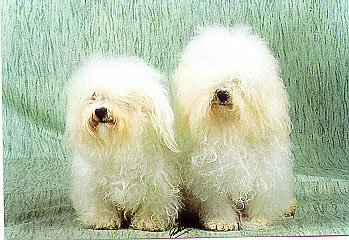Bolognese - Bologneser - Bichon Bolognais
| Breed Description | Breed Standard | Gallery | Links |

|
Bolognese - FCI Breed Standard
|
ORIGIN
: Italy
UTILIZATION : Companion dog FCI's CLASSIFICATION : Group 9: Companions and Toys - Section 1: Bichons and related Breeds. Without Working Trial.
DATE OF PUBLICATION OF THE VALID ORIGINAL STANDARD
:
BRIEF HISTORICAL SUMMARY Its origins are confused with those of the Maltese, because its distant ancestors are the same little dogs mentioned in Latin by Aristotle (384-322 BC) under the denomination of "canes melitenses". Already known in the Roman era, the Bolognese appears most especially among the very appreciated gifts which were made during a whole era by the powerful of that world. Cosimo de Medici (1389-1464) brought no less than eight to Brussels as gifts to as many Belgian noblemen. Philipe II, King of Spain from 1556 to 1598, after having received two as a gift from the Duke d'Este, thanks the donor in writing saying "that these two little dogs are the most royal gifts one can make to an emperor". Bolognese are represented in paintings of Titian, of Pierre Breughel called le Vieux and Goya. GENERAL APPEARANCE Small size, stocky and compact, covered with a pure white coat long and fluffy. IMPORTANT PROPORTIONS Square built, the length of the body being equal to the height at the withers. BEHAVIOUR AND TEMPERAMENT Very serious, generally not very active. Enterprising, docile, very much attached to his master and his entourage. HEAD Of medium length, reaches 1/3 of the height of the withers. Its width, measured at the level of the zygomatic arch is the same as its length.
CRANIAL REGION
The skull of slightly ovoid (egg-shaped)
shape in the sagital direction and rather flat in its upper part, has rather
convex sides; the
FACIAL REGION
Nose - On the same line as the topline
of the muzzle; seen in profile, its foreface is on the vertical, is large
and must be black.
NECK Without dewlap; its length is equal to the length of the head.
BODY
The dog being of a square construction, the
length of the body, measured from the point of the shoulder to the point
of the buttock bone is equal to that of the height at the withers. Top
profile - The straight profile of the back, and that of the loin, slightly
convex, merge harmoniously in the line of the croup.
LIMBS
HINDQUARTERS
- Considered on the whole and viewed from the back,
they must follow a perfectly vertical line from the point of the buttock
GAIT/MOVEMENT - Free, energetic, with a noble and distinguished head carriage. SKIN - Well taut and welded to the body all over, the visible mucous membranes and the third eyelids strictly pigmented black. COAT - Type of hair - Long all over the body, from head to tail, from the top line to the feet, shorter on the muzzle, rather fluffy, thus not lying flat, but in flocks, never forms fringes. Colour - Pure white, without any patches nor any shades of white. SIZE AND WEIGHT - Height at withers: males 27 to 30 cm - Females 25 to 28 cm. Weight: from 2,5 to 4 kg.
FAULTS
- Any departure from the foregoing points constitutes
a fault which when judging must be penalized according to its seriousness
and extension; the
SERIOUS FAULTS
- Accentuated convergence or divergence of the
upper longitudinal axes; convex muzzle (Roman nose) - prognathism, if it
alters
DISQUALIFYING FAULTS - Undershot mouth - depigmentation of the nose - nose of any other colour than black - bilateral depigmentation of the eyelids - wall-eyed - tailless - shortened tail whether natural or artificial - any other colour than white - patches and flecks. Note - Male should have two apparently normal testicles fully descended into the scrotum. |
<< Home |
|
|